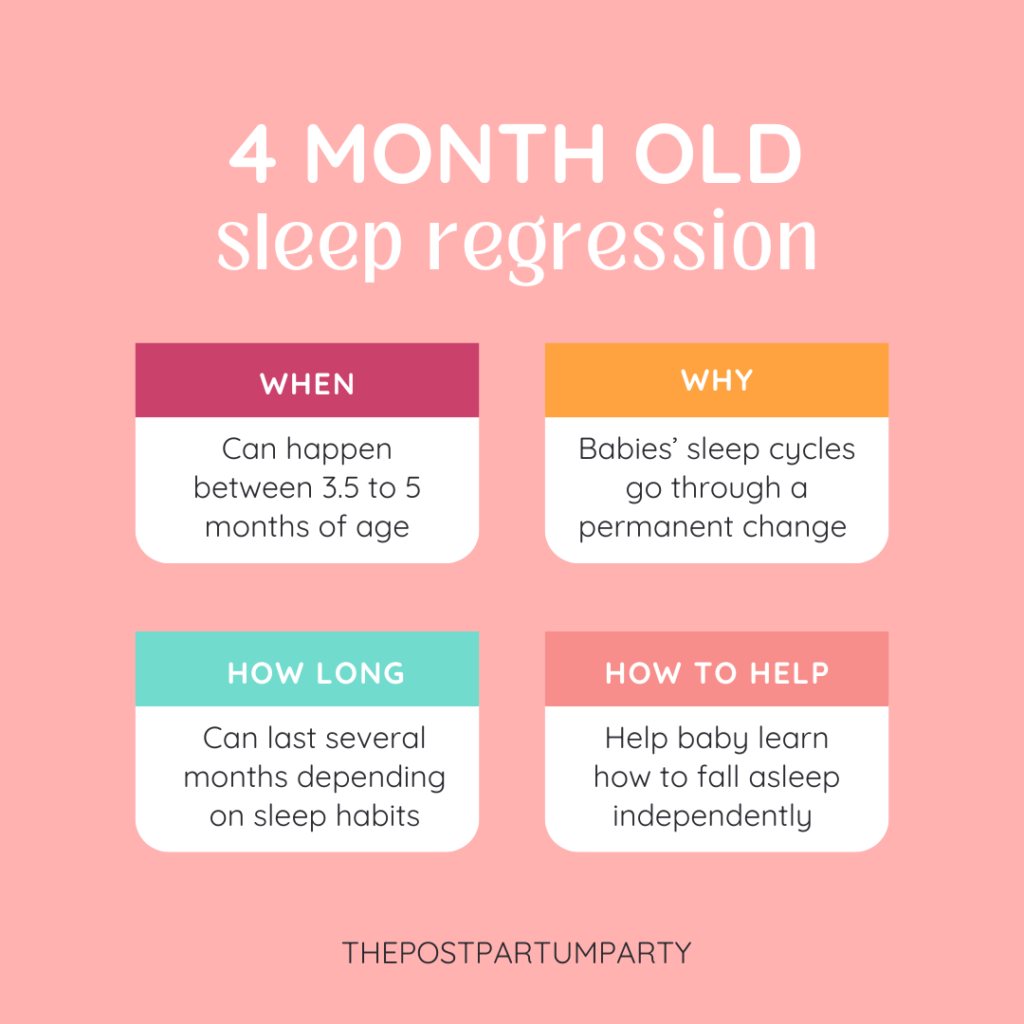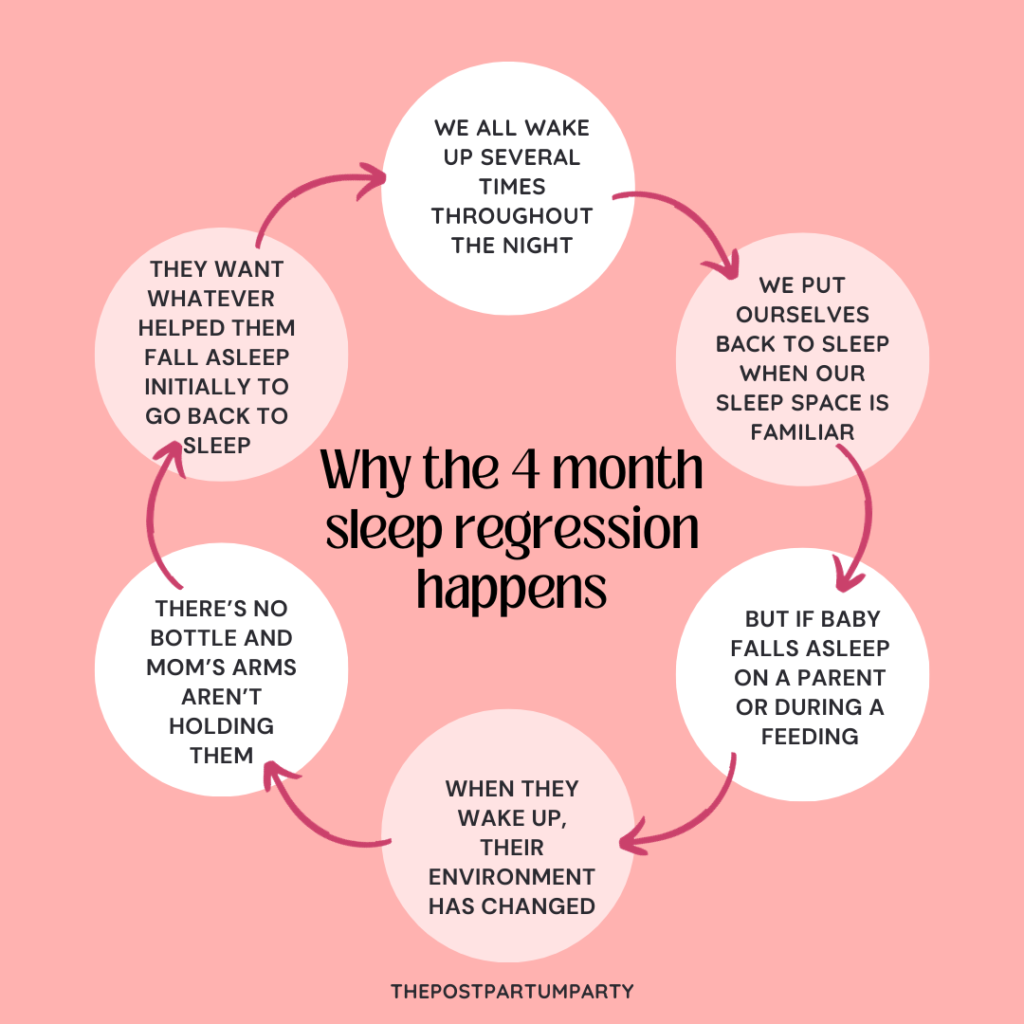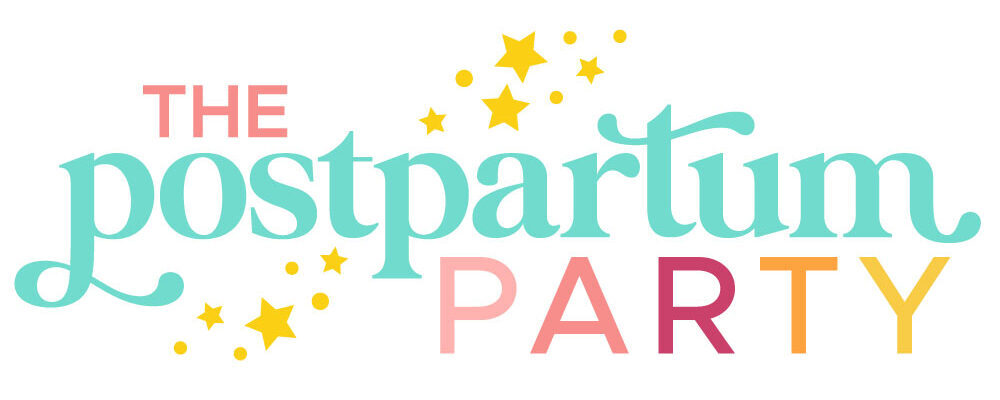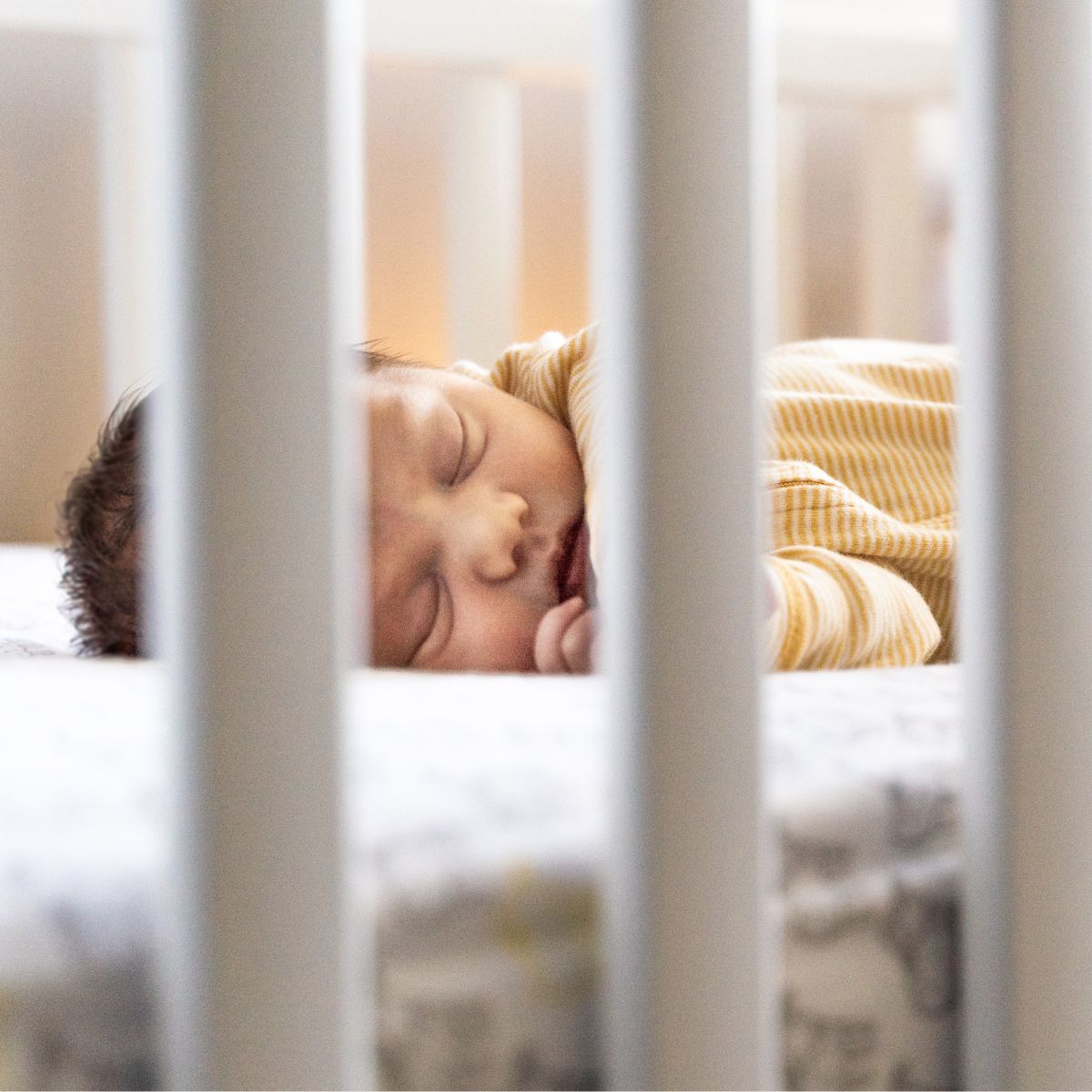Is your baby going through the 4 month sleep regression? Learn why this sleep regression happens and how you can get help your baby sleep.

The 4-month sleep regression is usually one of the first sleep regressions new parents encounter.
Your baby may have been sleeping well up until this point. You might have thought you sailed past all those newborn sleep horror stories you heard and then the four-month regression hits.
The 4-month sleep regression often comes from out of nowhere and can turn a new parent’s nights and life upside down.
Keep reading for tips on getting rid of the 4 month sleep regression and get your sleep back.

What is the 4 Month Sleep Regression?
The 4 month old sleep regression is often one of the first major disruptions to baby’s sleep that parents experience.
Up until this point, there have been lots of wakings for feedings, but newborns generally have no trouble getting right back to sleep.
The 4 month sleep regression occurs as your baby goes through the first big shift in their sleep development. You might all of a sudden be faced with a baby who you know is tired, but who is fighting sleep.
Why the 4-Month Old Sleep Regression Happens
Unlike other sleep regressions, this is a sleep regression that actually makes sense, scientifically speaking. (Though that doesn’t make it any easier to handle).
Around 4 months of age, big changes happen to your baby’s brain. Their sleep cycles change and become similar to our sleep cycles as adults. During the newborn stage, your baby slept really hard, which is why she probably slept through bright lights and loud noises for the first three months.
But around the four-month-mark, your baby’s sleep patterns change. And the 4-month regression can really start between 3.5 to 5 months of age.
We all wake up several times throughout the night, going in and out of different sleep stages. But we put ourselves back to sleep easily and unknowingly when we see our familiar bed, pillow, blanket, etc.
We don’t even realize it happens because we naturally connect sleep cycles and are able to come out of one sleep cycle in a light sleep and and go seamlessly into deep sleep into the next sleep cycle.
The 4-month sleep regression comes in as babies start to change from a newborn-like sleep cycle to an adult-like cycle. Couple that with the fact that your baby is learning new skills and hitting developmental milestones like rolling over in sleep and babies can really start to have a difficult time with sleep!
If your baby is rocked or fed to sleep, then it can be very strange for them to wake up in the middle of the night and be in a completely different environment than the one they fell asleep in. They may wakeup looking for your familiar arms or chest that helped them fall asleep initially.
It would be like if you fell asleep on a friend’s couch and then woke up in the middle of the night in their bathtub. Super weird, right?
As babies are rocked or nursed to sleep each time, they may start to wake up looking for the same sleep associations that helped them get to sleep in the first place.
They start to need this same sleep prop every time they come out of one sleep cycle in order to go into a new sleep cycle—which is about every 40 minutes.
A newborn waking up every 45 minutes or so is what makes the four-month sleep regression so hard for parents who are dealing with it. This creates scattered sleep and very long nights for the whole family in the middle of a four-month regression.

What are the Signs of the 4 Month Sleep Regression?
Babies are so complicated! Sometimes it’s hard to tell if they’re going through a growth spurt, developmental milestone, need their wake windows adjusted, or are dealing with a sleep regression.
The 4-month sleep regression is one of the easier sleep regressions to pinpoint though. (Although it’s not the easiest one to deal with!)
Here are some signs your baby may have hit the dreaded 4-month sleep regression:
- Your baby is between 3.5 and 5 months old. ( Yes, your baby can have the 4 month sleep regression at 5 months old. Four months is just a range in this case).
- Your baby was sleeping well but is suddenly having more frequent night wakings.
- Your baby is having a harder time going back to sleep after a middle-of-the-night feed.
- Your baby starts having a difficult time falling asleep at bedtime or for naps.
- Your baby takes short naps and starts waking up 30 to 45 minutes into her nap.
How Long Does the 4 Month Sleep Regression Last?
Most sleep regressions last anywhere from two to six weeks. The four-month sleep regression can come on suddenly and out of nowhere.
While other sleep regressions may stop just as soon as they began, the 4-month sleep regression is different, because your baby’s sleep has gone through a permanent change.
As the 4-month sleep regression hits, how you respond will determine how long it lasts.
If you start new sleep associations like feeding your baby to sleep, then that will become your baby’s new normal.
If you rock or nurse your baby to sleep every time that she wakes up, then that will quickly become something she needs and you may have a hard time doing anything different. Learn how to stop nursing your baby to sleep.
If you work on helping your baby self-soothe, then the 4 month sleep regression usually takes about 2 to 4 weeks to fully pass.
Get Better Sleep with The Baby D.R.E.A.M. System
If you want someone to walk you through the process of sleep training, let me help. The Baby D.R.E.A.M. System is for babies 4 months through 2.5 years old. I’ll walk you through how to establish daily routines, sleep schedules, and sleep training techniques to help you break the sleep associations you no longer find beneficial! Check it out here.
What Happens after the Four-Month Sleep Regression?
This will really depend on how you and your partner respond when your baby wakes up during the four-month sleep regression. If your baby gets used to being fed, held, or rocked to sleep, then they will most likely need those same things to get back to sleep each time they wake up.
Introducing new sleep props out of desperation can affect your child’s sleep for many months to come.
Make sure to keep your baby from getting overtired and try putting her down awake so she learns independent sleep skills.
If you stay consistent with the tips below in our sleep regression solution section, then the regression will exit just as quickly as it entered.
Watch the Video
Want a video explaining the 4 month old sleep regression and how you can help your baby sleep again? Click play below! Or keep on reading for more information about this sleep regression.
How Do I Get Rid of the 4 Month Sleep Regression?
If your baby is going through the 4 month regression, the good news is there are things you can do to get your good sleeper back.
Follow these tips for a 4 month sleep regression solution and to kick it to the curb.
1. Check Wake Windows and Baby’s Sleep Schedule
If you haven’t already, now is a great time to start your baby on a consistent sleep schedule. Follow 4-month old wake windows and a consistent 4-month sleep schedule.
Your 4-month old can stay awake for about 1.5 to 2 hours in between naps and needs between 3 to 4 naps each day with about 12 hours of night time sleep.
2. Have A Consistent Bedtime Routine
Baby’s can start to recognize routines early on. Establishing your baby’s bedtime routine will help cue to your baby’s brain that sleep is coming and help prepare them for sleep.
Following the same series of events each night can really help. We recommend feeding, diaper change, pajamas, books, and bedtime.
3. Create A Conducive Sleep Environment
Make sure your baby is sleeping in a dark room that is optimized for sleep. Use a white noise sound machine and blackout curtains to help optimize your baby’s sleep. Many babies are ready to drop the swaddle and transition to a sleep sack around this age as well.
4. Awake, Not Drowsy
Your baby’s sleep has changed. Start putting your baby down fully awake.
Drowsiness is the first step to falling asleep so it’s important that your baby doesn’t get help getting to drowsy.
Try to separate feedings from sleep by 30 minutes and put your baby down fully awake so she can enter drowsiness on her own.
5. Sleep Train
You can use a sleep training method to help your 4-month old start falling asleep on their own.
4 Month Old Sleep Regression FAQs
Is the 4 month sleep regression A myth?
The 4 month sleep regression is no myth—just ask the parents who are in the throes of the 4-month sleep regression or who have gone through it! In fact, this is the first sleep regression that most families encounter. Experiencing a sleep regression for the first time with your baby can be a super disruptive experience.
Do all babies have A 4 month sleep regression?
You hear it over and over again from your pediatrician and parenting peers (and me!), but every baby is different. Not every baby will go through every sleep regression.
If you’ve already started fostering healthy sleep habits with your little one—like avoiding nursing to sleep—this sleep regression might totally pass you by. But even if it hits you, you haven’t done anything wrong, I promise!
Why does the 4-month sleep regression happen?
The biggest reason for this sleep regression is a change in your baby’s sleep cycle.
Around this age, babies’ sleep cycles begin to more closely resemble an adult sleep cycle—that means sleeping more lightly, with a greater chance of waking up between cycles. If your baby hasn’t developed independent self-soothing skills, they’ll wake up and look for help from you.
How long does the 4-month sleep regression last?
As is typical with most sleep regressions, you can expect the 4 month sleep regression to last anywhere between 2 to 6 weeks. It might feel like eternity, but there’s light at the end of the tunnel.
If you’re able to avoid introducing sleep associations like bouncing, rocking, or nursing to sleep, you may notice that this sleep regression will last less than four weeks. Any new sleep associations you begin during a regression will be hard to break, so try not to start anything you don’t want to continue.
How can I help my baby sleep better during the regression?
The best thing you can do for your baby’s sleep during a regression is to stay consistent. Avoid the temptation to do absolutely anything you can to get your baby to sleep, because whatever methods you use tend to stick.
Should I adjust my baby’s sleep schedule during the 4-month sleep regression?
I know it’s so tempting under pressure to throw all convention to the wind and go into survival mode! But what your baby needs during a sleep regression is consistency.
My one caveat for this, however, it to examine your baby’s wake windows and make sure you’re using a schedule that’s most appropriate for their age.
Around the 4-month mark, your baby’s wake windows should be between 90-120 minutes, with the shortest wake window at the beginning of the day. If you’re still working with 3 month old wake windows (around 90 minutes for all), it’s time to look at expanding some of your baby’s wake windows.
Are there any sleep training methods that can be used during the regression?
Yes. If your baby hit the 4 month regression a little early, I would recommend the Shush-Pat Method.
If your baby is older than 4 months and weighs at least 12 pounds, you could potentially start a more formal method of sleep training. Just remember that sleep training takes discipline from all caretakers involved, so only start when you feel ready.
Is it normal for my baby to wake up more frequently during the night?
It makes sense that your baby would be waking up more frequently at night during the 4 month sleep regression. They’re not sleeping as deeply as they were in those newborn days.
When adults move from one sleep cycle to the next at night, we typically are in a lighter sleep, too. We’re just more adept at getting right back to sleep because we know we are in our own cozy bed, safe and sound.
It’s going to take your baby a little time to learn that they don’t need your help to get back to sleep in between sleep cycles.
If your baby is waking up more frequently now for night feedings, try to assess if they’re hungry or looking for help getting back to sleep.
What can I do if my baby refuses to nap during the day?
If your baby is taking naps that are too short or is fighting naps altogether, it’s time to take a good look at their daily schedule and wake windows.
If they’re still on a four-nap schedule, they might be approaching the 4 to 3 nap transition.
It’s very possible that your baby isn’t building up enough sleep pressure to make them sufficiently tired for nap time. Make sure their wake windows are long enough, and start taking steps to transition to three naps if you see signs that they’re ready.
How can I prepare for the 4 month sleep regression?
You might be able to avoid the 4 month sleep regression altogether if you establish good sleep habits early on. Try to put your baby down awake and let them put themself to sleep, so they learn this skill. Establish a good sleep routine early on and you might just sail through the regression!
- Practical Tips if your Toddler is Going Through A 3-Year Old Sleep Regression - April 26, 2024
- Baby Led Weaning vs Purees — Which Should I Choose? - April 25, 2024
- 10 Adorable Letter Board Pregnancy Announcements - April 25, 2024








